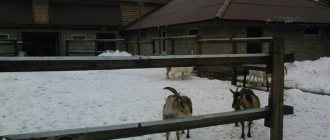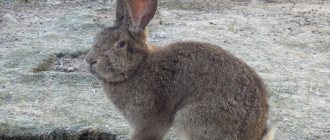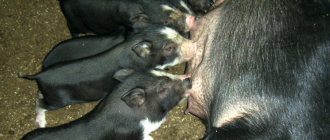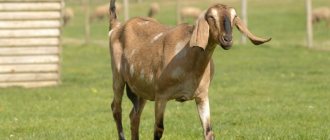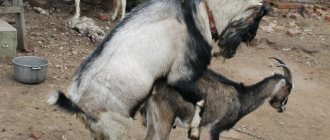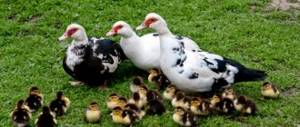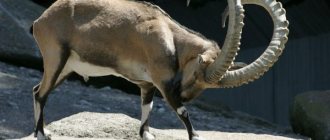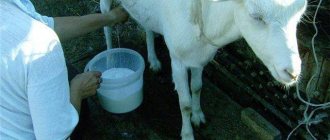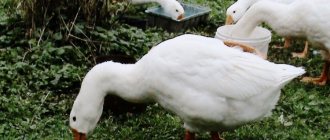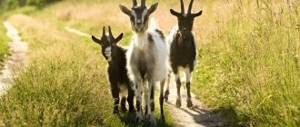Features of purchasing dairy, wool and meat sheep
Buying a goat is not an easy task, especially for beginners. There are many little things that inexperienced goat breeders do not pay attention to when buying goats. The result of such carelessness is low milk yield, illness and other problems.
Tips for choosing and purchasing goats:
- Dairy. Dairy goats are the hardest to choose. The main thing you should pay attention to when buying a dairy goat is age, body type, and signs of milk production. What you need to know: Carefully inspect every part of the animal's body.
- You shouldn't buy one goat - take at least two.
- Don't take goats wherever you have to. Contact a goat farm. But be sure to pay attention to the living conditions and diet of the animals, and ask about the pedigree.
- If you need highly productive goats, take purebred goats - they are more expensive, but they give much more milk than their “simple” relatives.
- Try feeding a goat - give it a cracker. If the animal is young, it will quickly grind the cracker with its teeth. The old goat's teeth have been worn down, and she will munch on solid food for a long time.
- Goat farmers have a proven method by which they determine whether the milk will smell. The animal must be stroked thoroughly between the horns, and then sniffed at the hand. If the hand does not smell of anything, then the milk will be odorless - and this is exactly what is valued in dairy breeds.
- The milk yield is not affected by the presence or absence of earrings on the neck, ear shape and color.
Goats are sociable animals; they feel sad when alone. Moreover, melancholy causes hyperactivity in them - the behavior of animals becomes problematic.
If the goat is dull, with dull hair, poor appetite and a sagging belly, immediately refuse this option.
How to achieve high milk yield?
If the purpose of purchasing a domestic goat was to obtain significant volumes of milk, then it is necessary to put into practice some useful techniques. With their help, any novice farmer will be able to increase their daily milk yield:
- The area where the goat is kept must have ventilation conditions. The room should be kept clean and warm, free of any drafts. However, it is important to fill your goat's feeder with quality hay. To prevent it from becoming empty, you should periodically add fresh food to it. In winter, the temperature in the stall should be at least 6 degrees Celsius.
- The food that serves as nutrition for the goat must be rich in a complex of vitamins and microelements. It is not advisable to frequently alternate brands of nutritional food. This will prevent a decrease in milk volume due to animal illness.
- Experienced farmers who know a lot about animal husbandry recommend giving goats chamomile, while reducing the amount of potatoes.
- It is necessary to constantly monitor the appearance of animals. Before milking, it is recommended to thoroughly wash the goat's udder and your hands. If you milk an animal with dirty hands, you can introduce bacteria into the animal's milk, which will lead to further illness.
A dairy goat is a useful animal suitable for farm farming. She brings milk, wool and meat to her owner. The price for a young or adult goat may differ based on certain factors. An individual that is distinguished by productivity will cost more than others. According to statistics, the volume of milk obtained depends 30% on the breed and characteristics of the animal and 70% on proper care.
During the female's pregnancy, the owner needs to monitor her condition and proper diet. During this time period, the individual needs increased attention from the farmer.
What to look for when purchasing?
When choosing a dairy goat, they are looking for an animal that is not only healthy, but also milk-producing. A healthy goat has thin and transparent ears, it breathes silently, its eyes are bright, and its nose is clean. In order not to rely on the honesty of sellers, learn to independently determine how productive a goat is. To do this, it is enough to examine its general exterior, udder, hooves, teeth and some other parts of the body.
Body type
On average, an ordinary goat weighs 50-60 kg. Breeds with a large build produce more milk - their digestive system processes more feed, and accordingly, their milk yield is higher than that of goats of average build.
Dairy goats, unlike meat and feather goats, look leaner and more angular. Signs of a well-built dairy goat:
- chest – wide;
- neck – thin, medium length;
- ribs – long, convex;
- rear – wide, non-saggy;
- belly – voluminous;
- legs – set wide apart;
- The body is long, barrel-shaped, with strong bones.
When choosing a goat, look at it from the side - the front and back of the body should be on the same straight line. And if you look from behind, you can clearly see the arched pelvis - high and wide.
Udder and nipples
The udder of a productive goat is clearly visible when viewed from any side - front, side and back.
Signs of a good udder:
- shape – bowl- or pear-shaped;
- no hair;
- elastic, not saggy – when squeezing, resistance is felt;
- the skin is thin, elastic, no hardening;
- milk veins are clearly visible;
- after milking, the udder falls off, its skin gathers in small folds.
If the udder does not match this description, the goat will not produce much milk. If the udder is large, it can hold and hold a lot of milk. Goats with large udders are milked only 2 times a day. An udder that is too round indicates obesity, which is incompatible with high milk yield.
When examining the udder, pay attention to the nipples, they should be:
- elastic;
- cylindrical;
- medium size;
- directed slightly forward and to the sides.
It is strictly not recommended to buy a goat that:
- small nipples;
- nipples are turned inward;
- the udder dangles while walking;
- the udder is clearly divided into two parts.
Please note that there are serious nipple defects - there are extra nipples, blind nipples, double nipples, and without holes.
Oral cavity
The age of the animal is determined by the teeth. If you don't understand goat teeth, you may be sold an old animal that will be of no use in the future. A goat has a total of 32 teeth. 6 teeth on each side - 24 in total. And 8 more incisors. The age of the animal is determined by assessing the condition of the incisors.
How goat teeth develop:
- From birth to 10 days – the toes grow. These are milk incisors - 2 pieces. Then 6 more incisors grow. A year later, the first pair falls out - molars grow, wider than the first teeth.
- Every year, until the age of three, a pair of incisors is replaced. Until the age of 4 years, the last pair of outer incisors is replaced.
- Upon reaching 5 years of age, goats' teeth begin to wear down, becoming oval in shape.
- At 6 years old, the incisors are almost round, with gaps appearing between them.
- By the age of 7, teeth wear down, begin to loosen and fall out.
- After 7 years, teeth become completely unusable. Instead of teeth, only stumps remain. The animal cannot chew food normally.
Animal age
It is best to buy a goat that is 2-3 years old. Maximum milk yield begins after 2-3 lambings. At the age of 6-7 years, milk yield drops. The age of an animal is determined by its teeth. An old animal, losing its teeth, is not able to chew food well, and its maintenance becomes unprofitable.
Wool
Wool is an indicator by which only the health status of the animal is determined; its type and length do not directly affect milk yield. A healthy goat's fur is soft and shiny, not rough to the touch. If you choose between dairy goats with different hair lengths, then preference should be given to short-haired ones - they are easier to care for. But in the northern regions, the best option is downy goats for milk production.
When choosing a wool or down goat, it is important to consider the productivity of their ancestors. Therefore, it is advisable to find out from the owners the pedigree of the candidates. Buy goats of wool and downy breeds before combing and shearing.
Hooves
Goats' hooves should be fine. Healthy animals do not limp; their hooves are strong and undamaged. Caring owners trim and treat hooves on time. Otherwise, it is uncomfortable for the goat to walk, it will not be able to fully eat and drink, most of the time the animal tries to lie down.
If the hooves are not trimmed, dirt accumulates in their tucked horns and bacteria multiply. Animals can get foot rot. They buy goats only with clean and well-groomed hooves - otherwise there will be no problems. If the owners did not take care of the hooves, then they could well underfeed the animal, which would certainly affect its productivity.
How to choose the right kid?
When buying a kid, they look for active and healthy animals with the right appearance. The baby goat's weight should be appropriate for its age. Table 1 shows the dependence of weight on the age of the animal.
Table 1
| Age, months | Weight, kg |
| 1 | 8 |
| 2 | 12 |
| 3 | 17 |
| 4 | 21 |
| 5 | 26 |
| 6 | 28 |
| 7 | 30 |
| 8 | 33 |
| 9 | 35 |
| 10 | 37 |
| 11 | 40 |
| 12 | 42 |
Tips for choosing kids:
- You should not take kids younger than 3 weeks. Until this age, animals do not tolerate the road well.
- The back should be straight, not sunken or hunchbacked. A slight sagging is acceptable only in the Nubian breed.
- No flaws are allowed on the kid's face. Especially narrow jaws - such a defect will not allow the animal to fully feed. Chewing with narrow jaws, it will quickly get tired, which will lead to malnutrition and developmental delays.
- It is advisable to take dehorned kids, since horns are a risk factor and animals can injure each other.
- Tail – vertical or relaxed, but not tucked.
- The stool is hard balls, diarrhea is not allowed.
- The position of the hooves indicates the width of the chest. The arch between the thighs should be wide enough - this is where the udder of females will be located.
- Check to see if the animal has any bumps or other defects on its skin.
- Goats are always larger than female goats; if a kid is smaller than a goat, or the same size as it, it lags behind in development.
- When buying a goat, pay attention to its scrotum - normally the testicles are lowered to the same distance and not retracted. Otherwise, the animal will be difficult to castrate.
The most popular goat breeds
During breeding, selection has reached almost perfection - breeds have been bred that are almost ideal. They are very tenacious and almost do not get sick, they can adapt to the harshest conditions, they produce a lot of milk - tasty, without the specific smell that the products of less valuable breeds have.
Saanen goat
This is a large breed - animals reach 90 cm at the withers. Weight – up to 100 kg. The Saanen is the most popular dairy breed. They are famous for their fertility and productivity. Read more about this goat breed here.
Features of the Saanen breed:
- white short hair (the cream subspecies is extremely rare);
- short horns;
- strong legs;
- wide bones;
- wide muzzle;
- strong long neck.
The female gives up to 700 liters of milk per year. Thanks to a balanced diet, milk yield can be increased by 500 liters. An important plus is that wool does not have an unpleasant odor.
The record milk yield of the Saanen breed – 3507 kg – was set by a goat belonging to the German subspecies.
Russian white
An ancient breed, popular in the north and center of Russia. The weight of dairy goats reaches 50 kg. Lactation lasts 7 months.
Characteristic features of the Russian breed:
- color – white, has a beard;
- the length of the coat varies depending on living conditions;
- annual productivity – 600 liters of milk;
- give a lot of high-quality fluff;
- unpretentious to food and maintenance;
- The body is barrel-shaped, the ears are small, the nipples are directed straight.
Megrelian
The breed was bred in Georgia. It is bred in hot plateau conditions. There are two subspecies of Megrelian goats - for the mountains and foothills. The first ones are larger in size and weight. Mountain goats weigh up to 70 kg, their height is up to 60 cm. Foothill goats weigh 45-60 kg, but are not inferior to the mountain subspecies in productivity.
Features of the Megrelian breed:
- productivity – up to 900 liters per year;
- during the feeding period, the female gives up to 350 liters of milk;
- unpretentious and non-aggressive;
- elongated body;
- chest – wide;
- legs – straight;
- has a small beard;
- very high immunity;
- The coat is light, coarse and short.
The Megrelian breed is often used for crossing as a carrier of extremely strong immunity.
La Mancha
European breed, named after the Spanish province. Height – 75-95 cm. Weight of goats – 60-70 kg, goats – 55-65 kg. Find more information about the LaMancha breed here.
Features of the LaMancha goat breed:
- the body is powerful and strong;
- distinctive feature - Roman profile;
- goats can be kept for meat and milk;
- meat productivity – 70%;
- different colors - black, white, red, brown, spotted;
- milk fat content – 4%;
- Milk productivity – 5-6 liters per day, maximum – 9 liters.
Nubian
The Nubian goat breed was developed in England. Demanding about conditions of detention. The animals are large, at the withers – up to 74 cm. Weight – up to 80 kg. They are inferior in size and productivity to the Zannen goats. They are distinguished by an unusual exterior - this is a very beautiful breed.
Features of the Nubian breed:
- color - a combination of black, white and brown;
- no unpleasant odor;
- protein content in milk – 3.7%;
- animals are aggressive and active - it is recommended to burn the horns of young animals;
- milk yield during lactation is 3 liters per day, annual milk yield is at least 700 liters.
The main advantage of the Nubian breed is tasty and rich milk. Fat content reaches 4.5%.
Gorkovskaya
The breed was developed at the beginning of the 20th century. Has very high milk productivity. Weight of males – 80, kg, goats – 45 kg.
Features of the Gorky breed:
- productivity – up to 1200 liters per year;
- milk fat content – 4-5.5%;
- color – white, gray;
- Both sexes have horns;
- distinguished by high quality meat and skin;
- unpretentious in terms of maintenance and feed;
- normal milk yield begins only after the second lambing.
Toggenburg
The breed comes from Switzerland. The weight of Toggenburg goats reaches 80 kg, height – 65 cm. Coat color is gray or brown.
Features of the Toggenburg breed:
- the body is short, low set;
- legs are short, covered with long hair;
- productivity – from 600 to 900 liters per year;
- adapted to low temperatures.
Alpine
High Alpine goats were developed about a hundred years ago in the French Alps. The weight of large individuals reaches 76 kg, the height at the withers is 77 cm. Lactation is about 7 months.
Features of the Alpine goat breed:
- the milk is not as fatty as that of other breeds, and is closer in composition to human milk;
- milk has no smell;
- color – bay, dark, light;
- average productivity – 800 liters per year;
- show aggressiveness towards representatives of other breeds;
- They are able to adapt to any conditions, but under unfavorable conditions they lose productivity.
Czech brown
The ancestors of this breed are Alpine goats, French and Swiss. The weight of a male is up to 80 kg, a female is up to 55 kg.
Features of the Czech brown breed:
- color – brown of varying intensity, from brown to milk chocolate;
- distinctive feature - black triangles behind the ears;
- They are distinguished by good intelligence - they know their nicknames and can carry out some commands;
- lactation – about 10 months;
- milk fat content – 3.5%;
- They give 2-4 liters of milk per day; they can give up to 1.5-2 tons of milk per year.
German Pied
This prolific breed has a long lifespan and rapid acclimatization. The weight of females is 50-70 kg, males can reach 100 kg.
Features of the German motley breed:
- they bring several kids;
- color from dark to light brown;
- there is a black stripe on the back;
- come with horns and polled;
- legs straight;
- the body is elongated, the chest is wide;
- a very developed udder, convenient for manual and mechanical milking;
- productivity – 700-1000 liters of milk per year;
- fat content – 3.5%.
Cameroon breed
This breed comes from Africa. The main difference between the breed is its small size and extremely tasty milk. Height no more than 0.5 m.
Features of the Cameroonian breed:
- productivity - about 2 liters of milk per day;
- milk – fatty and tasty;
- horns - curved;
- there is a small beard on the jaw;
- adapt well to different conditions;
- undemanding in nutrition;
- have strong immunity.
What should you know when choosing an odorless dairy goat?
Farmers who keep some kind of livestock on their farm have a large income in the form of natural food products. Many farmers sell milk and meat on the market, receiving money for it. One milking individual can give a farmer 5000-9000 liters of milk per year.
Goat's milk has a high nutritional value compared to cow's milk product. The percentage of fat content, saturation with vitamins and minerals, as well as hypoallergenicity makes the product more valuable and in demand among others. On the Russian market, the cost for a mature goat ranges from 5 thousand to 25 thousand rubles.
Not all representatives of artiodactyls have the ability to withstand temperature changes or unusual climate conditions. Other purebred species live in special closed pens. With improper living conditions and living conditions, a decrease in their milk productivity is likely. These reasons make it difficult for the buyer to choose domestic goats purchased for further breeding and obtaining a natural goat product of the highest quality.
For this reason, farmers recommend initially familiarizing yourself with the characteristics, varieties and special features of goats.
For home farming, you should buy local subspecies of goats. Over the years, they were able to adapt to the climate of the surrounding area. At the same time, the inner lining of the stomach in representatives of artiodactyls sometimes leads to problems associated with the assimilation of food products when the diet changes. Therefore, it is better to buy breeds that are adapted to green fresh grass on pastures in a certain territorial location. In this case, it will be possible to reduce the risk of developing dysbacteriosis.
Raising domestic goats that are accustomed to living in a certain area will be cheaper compared to breeds purchased in other regions. Animals such as goats have the ability to eat grass in meadows and fields in the summer. Therefore, you should not spend money on buying mixed and roughage feed that meets standard standards. In winter, animals feed on previously harvested grass.
Comparative table of breed productivity
When choosing a goat breed, most often, buyers are guided by their productivity. It is especially important when choosing dairy and meat and dairy breeds. Comparison of milk productivity of the above-described breeds is in Table 2.
You can get more information about how much milk a goat can produce in this article.
table 2
| Breed | Average daily milk yield, l | Average milk yield per lactation, l | Average annual milk yield, l | Fat content, % |
| Alpine | 4 | 300-350 | 800-1200 | 3,5 |
| Gorkovskaya | 1,2-1,3 | 145-300 | 500-1000 | 5 |
| Saanen | 5 | 300 | 600-1200 | 4,5 |
| Cameroonian | 1-2 | 150 | 400-600 | 4,5-6 |
| La Mancha | 8 | 300 | 900-1000 | 4 |
| Megrelian | 1-2 | 200-250 | 400-800 | 5 |
| German Pied | 4-5 | 700-1000 | 850-1100 | 3,2-3,5 |
| Nubian | 4-5 | 300 | 900-1000 | 4,5-8 |
| Russian white | 2,5-3 | 300-550 | 500-600 | 4-5 |
| Toggenburg | 2,5 | 700-800 | 1000-1500 | 3-4 |
| Czech brown | 4-6 | 300-330 | 800-1000 | 3,5-4,5 |
Traditional Russian breed
This breed is considered one of the oldest. The habitat of the Russian goat is recorded in the central and northern parts of Russia. A distinctive feature of the breed is the white color of the coat and the presence of a beard. Depending on where the goat lives, the length of its fur may vary. But, there are also individuals with black and red coat color.
Note that the Russian breed of goats is smaller in size than the Saanen. Animal husbandry specialists do not identify specific proportions. They indicate that this factor has an impact on performance. The Russian White is considered a breed with high stamina and endurance. It is easy to care for such an animal because it is unpretentious. These are the main advantages of a goat, allowing you to give preference to this breed when choosing.
One Russian goat can produce 600 liters of milk per year. Moreover, animals tend to produce a volume of fluff. These artiodactyls are unpretentious to their habitat and diet. The weight of a mature female reaches 50 kg, and the lactation period exceeds 7 months. The Russian goat is also fertile. The body of the breed resembles the outline of a barrel. The animal's ears are small, the nipples are located in a straight direction.
Where to buy a good goat?
You can buy goats in any place where they are sold, but only specialized farms can guarantee the quality of the animals sold and their compliance with the breed.
When choosing between private sellers, markets, farms and breeding facilities, give preference to the latter two. This is especially true if you are buying a valuable breed. So, for example, the cost of a Saanen female, 3 months old, is about 50,000 rubles. To avoid risking such amounts, contact breeders-farmers who specialize in breeding pedigree livestock.
When choosing goats, there is no need to rush. Carefully analyze your capabilities, including financial ones, study the signs of healthy animals, decide on the breed, find a reliable seller, and only then go for live goods. The profitability of your entire enterprise depends on the right choice.
0
0
Copy link
